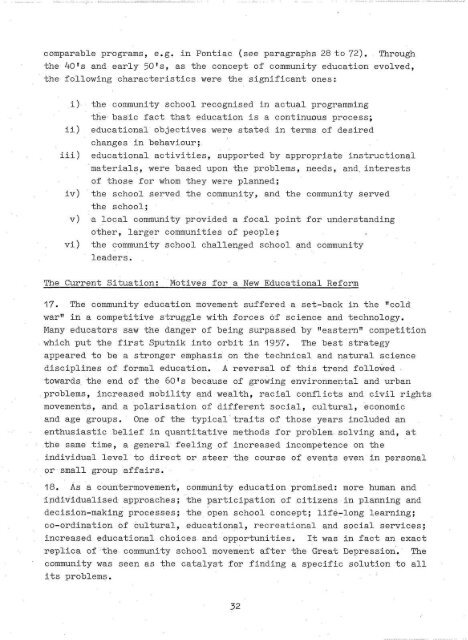BUILDING FOR SCHOOL AND COMMUNITY - Kennedy Bibliothek
BUILDING FOR SCHOOL AND COMMUNITY - Kennedy Bibliothek
BUILDING FOR SCHOOL AND COMMUNITY - Kennedy Bibliothek
You also want an ePaper? Increase the reach of your titles
YUMPU automatically turns print PDFs into web optimized ePapers that Google loves.
comparable programs, e.g. in Pontiac (see paragraphs 28 to 72). Through<br />
the 40's and early 50's, as the concept of community education evolved,<br />
the following characteristics were the significant ones:<br />
i) the community school recognised in actual programming<br />
the basic fact that education is a continuous process;<br />
ii) educational objectives were stated in terms of desired<br />
changes in behaviour;<br />
iii) educational activities, supported by appropriate instructional<br />
materials, were based upon the problems, needs, and( interests<br />
of those for whom they were planned;<br />
iv) the school served the community, and the community served<br />
the school;<br />
v) a local community provided a focal point for understanding<br />
other, larger communities of people;<br />
vi) the community school challenged school and community<br />
leaders.<br />
The Current Situation: Motives for a New Educational Reform<br />
17. The community education movement suffered a set-back in the "cold<br />
war" in a competitive struggle with forces of science and technology.<br />
Many educators saw the danger of being surpassed by "eastern" competition<br />
which put the first Sputnik into orbit in 1957. The best strategy<br />
appeared to be a stronger emphasis on the technical and natural science<br />
disciplines of formal education. A reversal of this trend followed •<br />
towards the end of the 60's because of growing environmental and urban<br />
problems, increased mobility and wealth, racial conflicts and civil rights<br />
movements, and a polarisation of different social, cultural, economic<br />
and age groups. One of the typical'traits of those years included an<br />
enthusiastic belief in quantitative methods for problem solving and, at<br />
the same time, a general feeling of increased incompetence on the<br />
individual level to direct or steer the course of events even in personal<br />
or small group affairs.<br />
18. As a countermovement, community education promised: more human and<br />
individualised approaches; the participation of citizens in planning and<br />
decision-making processes; the open school concept; life-long learning;<br />
co-ordination of cultural, educational, recreational and social services;<br />
increased educational choices and opportunities. It was in fact an exact<br />
replica of the community school movement after the Great Depression. The<br />
community was seen as the catalyst for finding a specific solution to all<br />
its problems.<br />
32
















